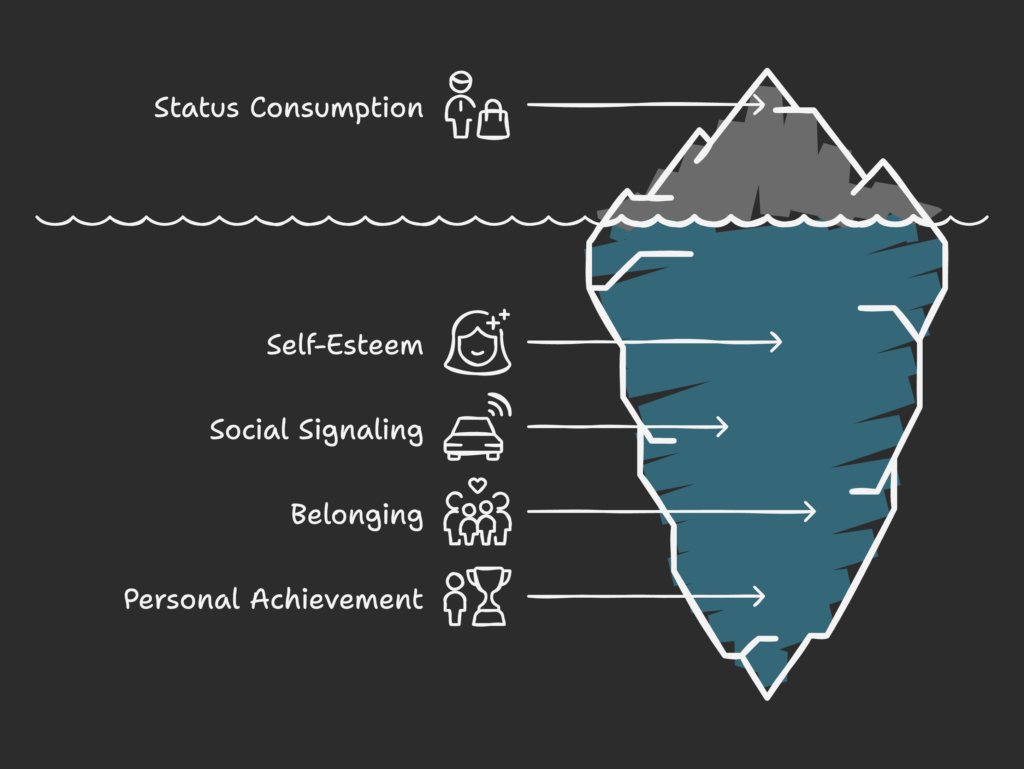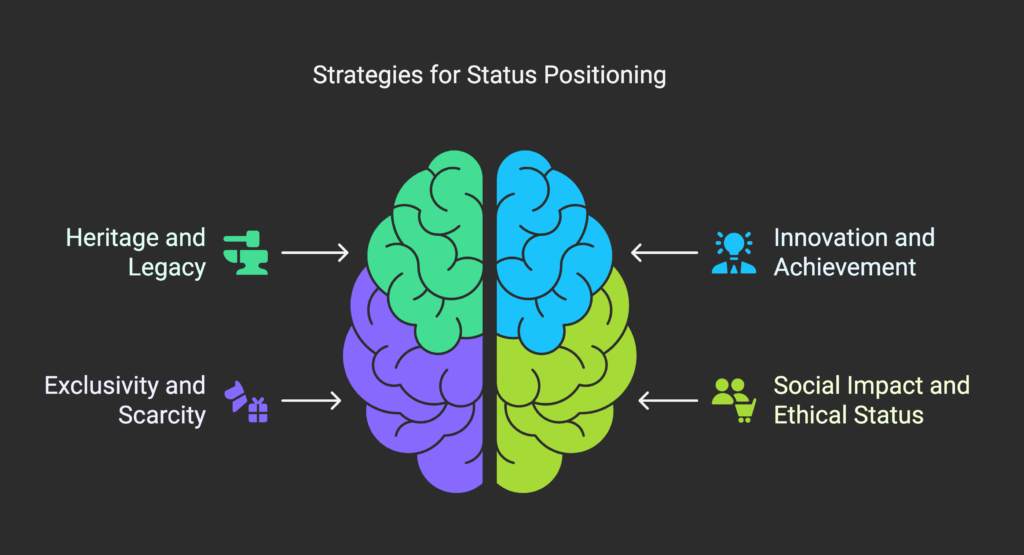Have you ever wondered why certain products carry an aura of prestige that makes people desire them at almost any cost? Or how a simple logo can spark envy or admiration from others around you? By the end of this article, you’ll discover the hidden forces that make people crave status products and how businesses leverage these forces to boost sales and loyalty. Ready to dive into the fascinating world of status-based product positioning? Let’s get started!
Introduction to Status-Based Product Positioning
In this section, you’ll learn how status-based product positioning works, why it matters, and how it has evolved through history. We’ll explore key psychological elements behind status symbols and why they hold such powerful sway in consumer culture.
Definition and Psychological Foundation
Status symbols are items or brands that signal a person’s social standing, success, or belonging to an exclusive group. Many people seek these symbols to gain admiration or approval from others, reflecting a deep-rooted need for social recognition. This need has evolutionary roots—across time, displaying resources or capabilities helped individuals secure respect and belonging within their communities.
Modern consumers also link status products to personal identity and achievement. Owning a luxury watch or a top-tier smartphone can feel like a tangible expression of hard work or personal success. It’s not just about the item itself; it’s also about feeling valued, acknowledged, and admired by others.
The Business Value of Status Positioning
For businesses, positioning a product as a status symbol often justifies premium pricing. Customers are sometimes willing to pay more than the product’s functional worth because of the pride they feel when owning it. These loyal customers can become lifelong advocates, sharing their enthusiasm through word-of-mouth and social media, which further enhances the brand’s exclusive reputation.
A successful status brand can also stand apart from competitors because it offers more than just functional benefits—it provides emotional value. This differentiation often makes it harder for other companies to break in and compete on the same level.
Historical Evolution of Status Consumption
Historically, status products were limited to aristocratic circles, where fine clothing, jewelry, and rare artifacts signaled wealth and heritage. Over time, mass production made luxury items more accessible, helping create what we now call “mass luxury.” The digital age accelerated this process by allowing consumers to show off their luxury items on social media, broadening the audience for conspicuous displays.
Today, new forms of status symbols have emerged, such as ethical or experiential products (like eco-friendly fashion or once-in-a-lifetime adventures). Status is no longer limited to shiny objects—it can also revolve around unique experiences or meaningful causes.
We’ve just explored how status positioning is rooted in psychology and history. Next, let’s uncover the driving forces that make people crave status in the first place.
The Psychology of Status Consumption
In this part, we’ll dive into the motives behind status consumption, how people flaunt (or subtly show) their purchases, and the emotional aspect of aspirational buying. By understanding the psychology, you’ll see how status-driven marketing can shape consumer behavior.

Motivational Drivers
One big motivator is self-esteem. People often feel a sense of pride or confidence when they possess items that society deems prestigious. Another factor is social signaling—letting others see you as successful or trendsetting. This can help you fit into certain groups or raise your standing among peers.
Additionally, many consumers buy status items for a sense of belonging. Whether it’s matching the lifestyle of a friend circle or demonstrating shared values with a community, these purchases can help someone feel accepted. And finally, on a deeper level, many see status products as markers of personal achievement, showing that they’ve reached a significant milestone in life.
Conspicuous Consumption Patterns
The term “conspicuous consumption” was famously introduced by economist Thorstein Veblen to describe how people publicly spend resources to showcase wealth or status. In today’s world, you might see this as “flexing” on social media—posting photos of new gadgets, limited-edition sneakers, or luxurious getaways.
Some people prefer flashy, visible status symbols (think oversized logos or ultra-expensive cars), while others opt for subtle signals (like a quietly prestigious brand tag or an elegantly minimal design). Cultural factors also matter—some societies place higher value on modesty, leading to more understated expressions of status.
Status Anxiety and Aspirational Purchasing
Because status is comparative, many people experience “status anxiety,” worrying about keeping up with peers or meeting cultural expectations. For marketers, this anxiety can be a powerful driver. If positioned ethically and authentically, brands can offer solutions that help alleviate those concerns—often by inviting consumers into a “better” or more exclusive world.
However, chasing status can be a never-ending cycle. Once one milestone is reached, many look for the next symbol to maintain the feeling of achievement. Brands that understand this dynamic can design offerings that balance aspiration and genuine value, so customers don’t feel like they are simply chasing empty prestige.
Now that we’ve uncovered why people seek status, let’s discover which groups are most receptive to status positioning and how they differ.
Market Segmentation for Status Positioning
Here, we’ll discuss the main segments that respond well to status-oriented products and how brands can tailor their strategies to each group. We’ll look at traditional luxury buyers, aspirational middle-market consumers, and niche communities that create their own status symbols.
Traditional Luxury Consumers
This group includes people from established wealth backgrounds (sometimes called “old money”) and new high earners (“new money”) who both value exclusivity. These individuals often look for heritage, craftsmanship, and deep-rooted brand narratives. They appreciate finely made goods and enjoy the sense of prestige that comes from owning something few people can access.
Despite differences in their history or taste, global elites often share similar purchasing patterns. They seek top-notch quality and may focus on collectibles or special items that reflect their personal expertise in luxury.
Aspirational Middle-Market Consumers
This segment includes those who save up or finance purchases to acquire more affordable luxury goods. They might start with entry-level products or discounted high-end items to feel connected to a prestige brand. Payment plans, membership perks, or loyalty rewards can make these items more attainable.
For businesses, the challenge is offering a product that feels luxurious without undermining the brand’s exclusivity. It’s a delicate balance between accessibility and high-status appeal.
Status Niches and Micro-Communities
Not all status symbols revolve around wealth. Some revolve around hobbies, professions, or even digital spaces. For instance, a high-end gaming rig can be a status symbol within gamer circles. Or a specialized piece of artisanal equipment can hold prestige in certain enthusiast communities.
Brands that tap into these niche groups often build strong loyalty, as the status signal is uniquely tied to shared passions, professional achievements, or subcultural identities.
We’ve identified the “who.” Next, let’s look at the “how”—the strategic methods that brands can use to position themselves as status symbols.
Strategic Approaches to Status Positioning
In this section, we’ll explore different ways companies can create and maintain a status-centric image. You’ll see how heritage, innovation, exclusivity, and social impact can each become core strategies for standing out in the market.

Heritage and Legacy Positioning
Many renowned brands emphasize a rich history or tradition to convey authenticity. By showcasing craftsmanship, artisanal techniques, or family legacy, these companies suggest that their products have timeless value. This strategy often turns items into collectibles or heirlooms that can be passed down through generations.
Innovation and Achievement Positioning
Some products become status symbols because they’re seen as the pinnacle of innovation or performance. Think of cutting-edge technology, electric cars, or sophisticated design that outperforms everything else on the market. Consumers who value being “first” or “best” are drawn to these advancements as a way to signal their forward-thinking mindset.
Exclusivity and Scarcity Strategies
Limited editions, waitlists, and membership-only offers create an atmosphere of exclusivity. When people believe an item or experience is rare, it automatically becomes more desirable. Scarcity can be artificially maintained or naturally occurring (like rare materials or a small production run). Either way, it heightens the sense of privilege that comes with ownership.
Additionally, personalizing or customizing items—like engraving initials or tailoring specific features—makes them feel special and unique, further boosting their status value.
Social Impact and Ethical Status
In recent years, many consumers want more than just glamorous logos. They want products with a positive social or environmental impact. Buying a premium product that’s ethically sourced or linked to a philanthropic cause can provide an emotional lift that goes beyond mere luxury. In this way, sustainability and kindness can become modern status markers.
We’ve seen the strategies. Up next, let’s look at how to apply them across the entire marketing mix to create a cohesive, high-status brand image.
Implementing Status Positioning Across Marketing Mix
This part focuses on bringing your status strategy to life through product design, pricing, distribution, and promotional tactics. By aligning all marketing mix elements, you create a powerful and consistent status message.
Product Design and Development
- Status-signaling design elements: Carefully choose materials, packaging, and details that convey exclusivity or quality.
- Visible branding versus subtle markers: Decide if your brand should boast a prominent logo or keep a discreet symbol that only insiders recognize.
- Complementary offerings: Consider an ecosystem of accessories or services that enhance the main product and deepen its luxury feel.
Pricing Strategies for Status Products
- Price as a signal: Higher prices can reinforce perceptions of quality and desirability.
- Prestige pricing: Maintaining a stable, premium price can help preserve exclusivity. Discounting should be approached with caution.
- Value articulation: Communicate the craftsmanship, research, or innovation behind your product, so consumers feel the price is justified.
Distribution and Retail Environment
- Selective availability: Distribute your products only through certain high-end stores or invite-only online platforms.
- Luxurious retail design: Ensure your physical or online store environment reflects sophistication and premium service.
- Well-trained staff: Employees should offer personalized, high-quality service to match the product’s status image.
Communication and Promotion
- Targeted media channels: Advertise in places where affluent or aspirational audiences will see your message.
- Celebrity and influencer partnerships: Align your product with individuals who embody the desired lifestyle or prestige.
- Community building: Encourage loyal customers to form social groups or events around the product, amplifying its status appeal.
With your marketing mix in place, it’s time to see how successful status positioning looks in practice. Let’s look at some real-world examples next.
Case Studies of Successful Status Positioning
Here, we’ll examine how various industries—technology, fashion, home goods, and services—have used status positioning to capture and keep a loyal audience. You’ll notice common themes of exclusivity, high-quality design, and strong brand narratives.
Technology and Consumer Electronics
Brands like Apple have built an entire ecosystem around premium design and user experience, fostering a cult-like loyalty. Tesla has reshaped the car market by blending high performance with eco-conscious innovation, making its vehicles both futuristic and prestigious. Even niche high-end audio companies enjoy cult followings from audiophiles who love owning the “best of the best.”
In gaming, high-performance PCs or specialized console editions can carry status within gamer communities. People are willing to pay more for graphics cards or accessories that showcase their commitment to top-tier performance.
Fashion and Accessories
Luxury fashion houses maintain exclusivity through runway shows, invitation-only events, and carefully curated brand stories. Watch brands often spotlight craftsmanship and heritage, with certain brands signaling a lifetime achievement or generational continuity.
Handbags vary widely in price tiers, but brand reputation remains key—some lines become iconic, turning them into powerful status statements. Streetwear has also evolved into its own prestige space, with limited drops and hype-driven releases fueling demand.
Home and Lifestyle Products
From high-end kitchen appliances to designer furniture, home items can be a reflection of personal taste and cultural capital. Sleek coffee makers, premium cookware, or rare collector’s furniture pieces all hint at a refined lifestyle.
Similarly, high-tech gadgets in the home—like advanced smart-home devices or top-tier workout equipment—can become status symbols in a world where innovation is prized.
Services and Experiences
Luxury travel and five-star hospitality appeal to travelers seeking once-in-a-lifetime memories. Financial services can offer exclusive credit cards with elite perks, while membership clubs promise special events and curated networking opportunities.
Even educational or self-improvement services can become status markers, especially if they’re selective, specialized, or carry a well-known brand name.
Having looked at these examples, how do we measure success and ensure that status positioning continues to deliver over time? Let’s find out.
Measuring Success in Status Positioning
In this section, we’ll explore the key performance indicators (KPIs) that reflect status brand success, as well as research methods to understand your brand’s place in the competitive landscape. We’ll also discuss balancing short-term wins with a long-term vision.
Key Performance Indicators
- Premium price maintenance: Are you able to sustain high prices without hurting demand?
- Brand aspiration: Do consumers express a desire to own your products, even if they can’t afford them right now?
- Social media buzz: How often is your brand mentioned or showcased in a way that indicates status?
- Customer lifetime value: Status buyers often return for multiple purchases over many years.
Research Methodologies
Brands can conduct perception studies, focus groups, or sentiment analysis to see how they’re viewed from a status perspective. Competitive analysis helps ensure you’re staying a step ahead. Social listening can reveal organic conversations, where consumers may discuss how certain products make them feel and how they compare with others.
Long-Term versus Short-Term Success Metrics
Short-term, you might aim for sales growth or social media spikes. But long-term, status positioning means building a legacy—ensuring your brand remains coveted as generations change. A steady approach preserves exclusivity and fosters sustainable desirability.
Next, we’ll look at the ethical side of building a status brand and the cultural considerations that come with it.
Ethical Considerations and Challenges
Even a status-focused strategy should remain honest and ethical. In this section, we’ll look at authenticity, social responsibility, and cultural sensitivity. By navigating these aspects carefully, brands can maintain a positive public image and genuine customer trust.
Authenticity and Value Delivery
To sustain a strong reputation, deliver real quality. Empty hype without substance can harm your credibility in the long run. Artificial scarcity can be useful, but only if it’s paired with actual uniqueness or craftsmanship that justifies it.
Customers want honesty, so ensure your status claims align with the real experience. If people sense they’ve been misled, your brand reputation can suffer quickly in today’s online environment.
Social Responsibility in Status Marketing
Some argue that status products amplify inequalities, while others see them as aspirational motivators. As a brand, consider how your products impact the environment or local communities. Many consumers appreciate and reward socially responsible brands, turning responsible practices into another key point of status differentiation.
Navigating Cultural Differences
Status can be very culture-specific. In some regions, outward displays of wealth are admired, while in others, quiet understatement is the norm. Doing research and adapting your brand strategy to each market’s cultural values can be critical.
Some signals, like philanthropic involvement or artisanal craft, may have universal appeal. Still, it’s wise to keep local sensitivities in mind when marketing globally.
Now, let’s look to the horizon. How will technology and shifting consumer values change the world of status positioning in the future?
Future Trends in Status Positioning
This part addresses upcoming developments such as digital products, new values around sustainability and knowledge, and the disruptive effects of advanced technology. These trends may reshape the way consumers define and pursue status.
Digital and Virtual Status Symbols
Non-fungible tokens (NFTs) are gaining attention as digital collectibles. In gaming and virtual worlds, rare in-game items can become status markers. Verification badges on social media also function as modern status icons. As virtual spaces expand, new forms of status ownership will likely emerge.
Evolving Status Values
Some consumers now prioritize experiences and personal growth over material objects. Knowledge and expertise—such as specialized skills or insider know-how—are becoming new forms of social currency. Sustainability and ethical production also attract consumers who want to showcase their care for the planet.
Technological Disruptions
Artificial intelligence can offer hyper-personalized products, making “custom for me” another status differentiator. Blockchain can verify authenticity, minimizing the risk of counterfeits. Direct-to-consumer models may challenge luxury retail, and augmented reality can create immersive ways to present high-end goods.
Let’s wrap it all up by outlining how you can build a long-lasting status brand and position yourself for future evolution.
Conclusion: Building Sustainable Status Positioning
This final section provides a guiding framework for brands that want to maintain authentic status over time. It’s about more than quick hype—it’s about building a brand identity that can thrive in a shifting world.
Strategic Planning Framework
First, align your status strategy with your brand’s core values and DNA. A clear vision ensures consistency across product development, marketing, and consumer experience. Aim for a long-term approach that slowly but steadily grows your reputation. It’s crucial to weigh how exclusivity might limit mass adoption while still maintaining profitability.
Implementation Roadmap
Assess your market potential, segment your audience, and allocate resources carefully for brand-building initiatives. You’ll need time to craft a reputation that resonates deeply with consumers. Measure your progress through brand perception studies and sales performance, adjusting your strategy as the market evolves.
Congratulations on making it through this deep dive into status-based product positioning. Ready for more insights? Below are some references, and then a final note on scaling your Shopify store.
References
- Ryviu. (2024, January 29). Product Positioning: The Complete Guide.
- AgileManía. (2025, February 10). What is Product Positioning? Key Strategies for Effective Branding.
- Product Marketing Alliance. (2025, February 18). What is positioning? Market, product & brand guide.
- LaunchNotes. (2024, November 13). Understanding What Product Positioning Is and Why It Matters.
- Besant, L. (2023, January 30). Flexing: Turn Products into Must-Have Status Symbols and Charge. LinkedIn.
- Yoganarasimhan, H. (2012). Brands as Status Symbols. ResearchGate.
- Mayple. (n.d.). The Complete Guide to Positioning in Marketing.
- DealHub. (2024, February 8). What is Product Positioning?
- Veblen, T. (1899). The Theory of the Leisure Class: An Economic Study of Institutions.
- Cialdini, R. B. (2007). Influence: The Psychology of Persuasion.
- Kapferer, J. N., & Bastien, V. (2012). The Luxury Strategy: Break the Rules of Marketing to Build Luxury Brands.
By the way, if you’re running a Shopify store, don’t forget to explore the Growth Suite app. It’s designed to help you boost sales, optimize product positioning, and reach more customers—all while keeping your brand image as polished and exclusive as you want it to be.




